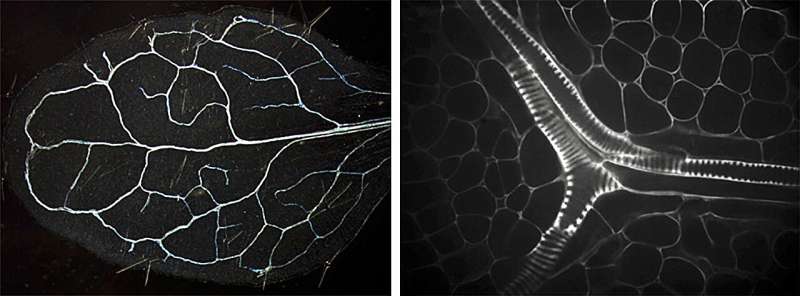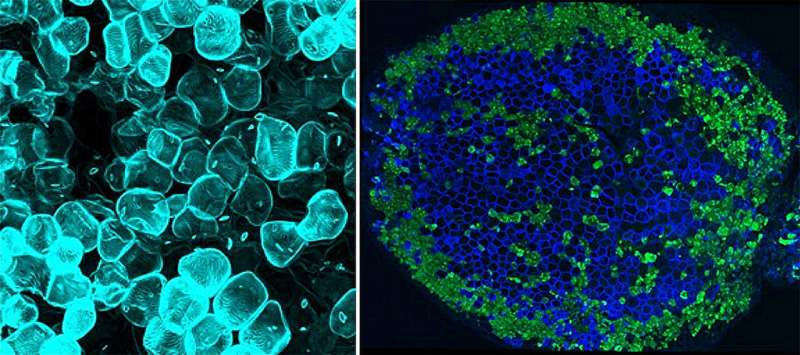This article has been reviewed according to Science X's editorial process and policies. Editors have highlighted the following attributes while ensuring the content's credibility:
fact-checked
trusted source
proofread
Recreating development in a petri dish to understand how plants live

Plants have an extremely high capacity to adapt to their environment. When the seeds of pea sprouts left over from cooking are soaked in water, the sprouts and leaves grow back. Associate Professor Kondo Yuki of Kobe University's Graduate School of Science has focused his research on vascular bundles, which are essential for environmental adaptation.
Vascular bundles have multifaceted functions, such as vessels for water and nutrient transport, plant body support, and electrical signal transmission, and were originally differentiated from vascular stem cells. He is trying to clarify how the fate of the diverse cells that make up these vascular bundles is determined using culture techniques developed in-house.
Kondo explains, "Vascular bundles are made up of a wide variety of cells, including vessel cells, which, like blood vessels in animals, transmit water and minerals absorbed by roots to leaves and shoots; sieve tube cells, which carry sugars and hormones produced by photosynthesis; fiber cells, which support the body; and cells responsible for loading and unloading substances into and from transport tubes."
"The fate of these cells branches out from vascular stem cells, which have pluripotency (can develop into any type of cell), and the process is similar to high school students choosing between science and humanities streams and narrowing down their choices for undergraduate studies. However, the mechanisms of how stem cells differentiate into different cells and perform their functions are largely unclarified. My research is motivated by the desire to tackle and unravel this mystery."
In the search for the fate-determining points of vascular stem cells, the plant scientist has developed a method for producing sieve tube and vessel cells from leaf cells of Arabidopsis thaliana. Using this method, which he has named VISUAL (Vascular cell Induction Culture System Using Arabidopsis Leaves), cells that are already destined to become leaves can be transformed into sieve tubes and vessels.
Furthermore, he succeeded for the first time in differentiating sieve tube cells, which had been considered difficult to study due to their lack of morphological characteristics, from vessel cells, which had already been induced to differentiate within vascular bundles.
Kondo explains, "When cotyledons (embryonic leaves) of Arabidopsis thaliana on a petri dish are cultivated for about four days with the plant hormones auxin and cytokinin as well as a compound known as bikini, the mesophyll cells that constitute leaves change their fate into large numbers of sieve and vessel cells."
"This is the VISUAL method we developed. Leaves originally possess chloroplasts responsible for photosynthesis since they are leaves, but when cultivation begins under a VISUAL environment, chloroplasts gradually break down."
"Although there are still many things that are not understood about its mechanism, this method allows leaf cells to be reset (reprogrammed) once and become stem cells with the potential to differentiate into various types of cells. Once they become stem cells, they seem to undergo rapid differentiation all the way to vascular bundle cells from that point onwards."

Research on plant cells contributing to the goal of carbon neutrality
VISUAL achieves the transformation of mesophyll cells into cells constituting vascular bundles. Furthermore, it has become clear that the reprogramming capacity varies depending on the concentration of hormones and compounds and the age of the leaves, so recently, he has been trying to produce only targeted cells by adjusting the culture conditions.
The Kobe University researcher explains, "Until now, only vessel and sieve tube cells could be produced, but by modifying VISUAL, I have also succeeded in inducing differentiation into sieve companion cells, which are adjacent to sieve tube cells and are involved in the maintenance of sieve tube cell life."
"Through tissue culture techniques, we can replicate the process of vascular bundle development in a petri dish, allowing us to observe the key factors involved in the fate determination of plant cells."
Based on previous research findings, Kondo also started initiatives related to the Sustainable Development Goals (SDGs). In a joint research project with the Faculty of Engineering of Kobe University, research is underway to design plant cells so that cellulose, which can be used as bioethanol, can be extracted efficiently.
Currently, extracting cellulose from wood requires a significant amount of energy to remove unwanted substances. However, Kondo aims to create cells that make the removal of unnecessary components easier without consuming energy by combining VISUAL and genetic modification techniques. This research represents a carbon-neutral effort using plant-derived energy and holds great promise as a measure towards two SDGs goals: energy and climate change.
Furthermore, research is underway to cultivate various types of plants using VISUAL, including ginkgo trees on the Kobe University campus. Trees that take several years to cultivate can be induced and analyzed in a few weeks with VISUAL, contributing to shorter cycles and greater efficiency in plant research.
The plant scientist has worked on a variety of research topics, from phytohormone signaling to fate determination and cell induction, but since his undergraduate days, he has been focused on vascular bundles in his research.
Kondo concludes, "The latest research shows that the environment in which plants grow, and the nutrients, such as sucrose, in the soil influence the development of vascular stem cells. Understanding this is precisely the goal of our research. Plants have the ability to survive in harsh environments, such as grass growing out of cracks in hard asphalt or the Jomon cedars on Yakushima Island surviving for thousands of years."
"Where does this power come from? I dedicate every day of my research to understanding the way plants live."
Provided by Kobe University





















